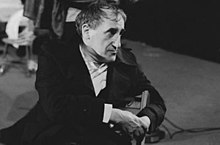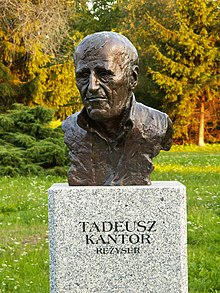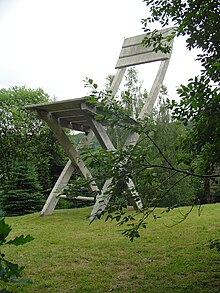| Revision as of 11:51, 12 November 2006 editSteel (talk | contribs)20,265 edits +Sprotected← Previous edit | Latest revision as of 20:47, 22 October 2024 edit undoPo Mieczu (talk | contribs)Extended confirmed users10,214 edits →Life and career: grammar | ||
| (157 intermediate revisions by more than 100 users not shown) | |||
| Line 1: | Line 1: | ||
| {{Short description|Polish painter}} | |||
| {{Sprotected}} | |||
| {{Infobox person | |||
| '''Tadeusz Kantor''' (], ] – ], ]) was a ] ], scene designer and ]. | |||
| | image = Tadeusz_kantor_17.jpg | |||
| | caption = Tadeusz Kantor | |||
| | birth_date = {{Birth date|1915|04|06|df=yes}} | |||
| | birth_place = ], ] | |||
| | death_date = {{Death date and age|1990|12|08|1915|04|06|df=yes}} | |||
| | death_place = ], ] | |||
| | nationality = ] | |||
| | other_names = | |||
| | occupation = Theatre director, artist | |||
| | years_active = | |||
| | known_for = | |||
| | notable_works = ''Dead Class''; ''Wielopole, Wielopole'' | |||
| }} | |||
| '''Tadeusz Kantor''' (6 April 1915 – 8 December 1990) was a Polish ], ] and ] artist, set designer and ]. Kantor is renowned for his revolutionary theatrical performances in Poland and abroad. Laureate of ] (1989). | |||
| Born in ], ] (in what was then ]). Kantor graduated from the ] in ]. During the Nazi occupation of Poland, he founded the Independent Theatre, and served as a professor at Kraków’s Academy of Fine Arts and a director of experimental theatre in ] from ] to ]. Following the war, he become known for his avant-garde work in stage design including designs for ''Saint Joan'' (]) and ''Measure for Measure'' (]). | |||
| == Life and career == | |||
| Becoming disenfranchised by the avant-garde's increasing institutionalization, in ] he and a group of visual artists formed a new theatre, ]. In the 1960s, he traveled widely with his theatre, becoming known for staging "happenings". His interest was mainly with the ]s and Polish writer ] (also known as "Witkacy"). ''The Cuttlefish'' (]) and ''The Water Hen'' (]) were his best known productions during this time. A 1972 performance of ''The Water Hen'' was described as "the least-publicised, most talked-about event at the ]". | |||
| Kantor was born to Marian Kantor-Mirski and Helena Berger. His family were staunch Catholics. His mother was related to composer and conductor ], through her German father. Born in ], ] (then in Austria-Hungary, now in ]), Kantor graduated from the ] in 1939. During the ], he founded the Independent Theatre, and served as a professor at the ] as well as a director of experimental theatre in ] from 1942 to 1944. After the war, he became known for his ] work in stage design including designs for '']'' (1956) and '']'' (1956). Specific examples of such changes to standard theatre were stages that extended out into the audience, and the use of ] instead of real-life actors. | |||
| In 1955, with a group of visual artists disenchanted with the growing institutionalization of avant-garde, he formed a new theatre ensemble called ]. In the 1960s, Cricot 2 gave performances in many theatres in Poland and abroad, gaining recognition for their stage ''happenings''. His interest was mainly with the ]s and Polish writer and playwright ] (also known as "Witkacy"). Stage productions of Witkacy's plays ''The Cuttlefish'' (1956) and ''The Water Hen'' (1969) were regarded as his best achievements during this time. A 1972 performance of ''The Water Hen'' was described as "the least-publicised, most talked-about event at the ]".<ref>{{cite news |last1=Ellis |first1=Samantha |title=Water Hen, Edinburgh, August 1972 |url=https://www.theguardian.com/stage/2003/aug/13/theatre |accessdate=10 May 2020 |work=The Guardian |date=13 August 2003}}</ref> | |||
| ''Dead Class'' (]) was the most famous of his theatre pieces of the 1970s. Within the piece, Kantor himself took the role of a teacher who presided over seemingly dead characters who are confronted by mannequins which represented their younger selves. He had began experimenting with the juxtaposition of mannequins and live actors in the 1950s. | |||
| ]]] | |||
| His later works of the 80s were very personal reflections. As in ''Dead Class'', he would sometimes represent himself onstage. In the 1990s, his works became well known in the ] due to presentations at ]'s La MaMa Experimental Theater Club. | |||
| ], Poland]] | |||
| ''Dead Class'' (1975) was the most famous of his theatre pieces of the 1970s.<ref>{{cite web |last1=Czerska |first1=Karolina |title=The Dead Class – Tadeusz Kantor |url=https://culture.pl/en/work/the-dead-class-tadeusz-kantor |website=culture.pl |accessdate=10 May 2020}}</ref><ref>{{cite book |last1=Romanska |first1=Magda |title=The Post-traumatic Theatre of Grotowski and Kantor |date=2012 |publisher=Anthem Press |page=201 |doi=10.7135/UPO9780857285263.029 |isbn=978-0-85728-516-4 |url=https://doi.org/10.7135/UPO9780857285263.029 |accessdate=10 May 2020}}</ref> A TV-Movie of the production was made in 1977, directed by ].<ref>{{IMDb title|176266|Dead Class (TV Movie 1977)}}</ref> In that play, Kantor himself played the role of a teacher who presided over a class of apparently dead characters who are confronted by mannequins representing the characters' younger selves. He had begun experimenting with the juxtaposition of mannequins and live actors in the 1950s. | |||
| His later works of the 1980s were very personal reflections. As in ''Dead Class'', he would sometimes represent himself on stage. In the 1990s, his works became well known in the ] due to presentations at ]'s ]. | |||
| Throughout his life, Kantor has had an interesting and unique relationship with Jews, despite being a nominal Catholic and having a father with anti-semitic tendencies, Kantor incoporated many elements of what was known as "Jewish theatre" into his works. | |||
| Throughout his life, Kantor had an interested and unique relationship with ]. Despite being a nominal Catholic, Kantor incorporated many elements of what was known as "]" into his works. | |||
| Kantor died in Kraków. | Kantor died in Kraków. | ||
| The new Centre for the Documentation of the Art of Tadeusz Kantor, {{ill|Cricoteka|pl}} was opened in Krakow in 2014. | |||
| ==Productions and works== | |||
| After the war he set up his own avant-garde theatre, ''Cricot 2'', where, amongst others, the works of Witkacy were presented: | |||
| *''The Cuttlefish'' (1956) | |||
| *''The Hyrcanian World View'' | |||
| *''In the Small Mansion'' | |||
| *''The Madman and the Nun'' | |||
| *''The Water Hen'' (1968) | |||
| *''Where Are the Snows of Yesteryear'' (1982) | |||
| *''Let the Artist Die'' (1985) | |||
| *''I Shall Never Return'' (1988) | |||
| *''Today is My Birthday'' (1990) | |||
| == Major manifestos and writing == | |||
| His most important works are: | |||
| *''The Autonomous Theatre'' (1963) | |||
| *''Theatre Happening: The Theatre of Events'' (1967) | |||
| *''The Informel Theatre'' (1961) | |||
| *''The Zero Theatre'' (1963) | |||
| *''The Theatre of Death'' (1975) | |||
| == Productions with Cricot 2 == | |||
| *''The Cuttlefish'' (1956) | |||
| *''The Country House'' (1961) | |||
| *''The Madman and the Nun'' (1963) | |||
| *''The Water Hen'' (1965) | |||
| *''Dainty Shapes and Hairy Apes, or the Green Pill'' (1972) | |||
| *''The Dead Class'' (1975) | *''The Dead Class'' (1975) | ||
| *''Wielopole, |
*''Wielopole, Wielopole'' (1981) | ||
| *'' |
*''Let the Artists Die'' (1985) | ||
| *''Macchina dell'amore e della morte'' (1987) | |||
| *''I Shall Never Return'' (1989) | |||
| *''Today is my Birthday'' (1990) | |||
| == See also == | |||
| His best known paintings are: | |||
| * ] | |||
| *''Man with Umbrella'' (1949) | |||
| *the ''Industrial bags'' series (1964) | |||
| *''Emballage'' (1964 - 1975) | |||
| *the ''Nothing any more'' series (1986 - 1990) | |||
| *''September Defeat'' (1990) | |||
| ==References== | ==References== | ||
| {{Reflist}} | |||
| # Kobialka, Michal, ed and trans. "A Journey Through Other Spaces: Essays and Manifestos, 1944-1990." Publisher: University of California Press, 1993. ISBN 0-520-08423-3 | |||
| # Wilson, Edwin. Goldfarb, Alvin. ''Living Theatre: A History''. Publisher: McGraw-Hill, 4th edition. August 5, 2003. ISBN 0-07-256257-9 | |||
| == Further reading == | |||
| ==External links== | |||
| * Kobialka, Michal, ed and trans. "A Journey Through Other Spaces: Essays and Manifestos, 1944–1990." Publisher: University of California Press, 1993. {{ISBN|0-520-08423-3}} | |||
| * Centre for the Documentation of the art of Tadeusz Kantor | |||
| * Kobialka, Michal, Author, ed and trans. "Further on, Nothing: Tadeusz Kantor's Theatre." Publisher: University of Minnesota Press, 2009. {{ISBN|978-0-8166-5481-9}} | |||
| * ]. ]. ''Living Theatre: A History''. Publisher: McGraw-Hill, 4th edition. August 5, 2003. {{ISBN|0-07-256257-9}} | |||
| * Krzysztof Pleśniarowicz, Kantor. Artysta końca wieku, Wrocław 1997. | |||
| * Pleśniarowicz, Krzysztof, Author, Brand, William trans. "The Dead Memory Machine. Tadeusz Kantor's Theatre of Death", Publisher: Black Mountain Press. Centre for Performance Research, Aberystwyth, 2004 {{ISBN|1-902867-04-1}} | |||
| == External links == | |||
| {{commons category-inline}} | |||
| * at culture.pl | |||
| * The Centre For the Documentation of the Art of Tadeusz Kantor | |||
| * | |||
| * | * | ||
| * | |||
| * images of Edinburgh performances by Tadeusz Kantor | |||
| * at The Royal Scottish Academy of Art & Architecture | |||
| * {{webarchive |url=https://web.archive.org/web/20061025145557/http://www.blinkred.com/gallery/static/da_kantor01.asp |date=October 25, 2006 |title=Demarco European Art Foundation }} images of Edinburgh performances by Tadeusz Kantor | |||
| * Details of show being performed in Edinburgh 2007 based on Kantor | |||
| * | |||
| * Here are several dated examples of Tadeusz Kantor signature. | |||
| * | |||
| {{Authority control}} | |||
| {{Witkacy Prize - Critics' Circle Award}} | |||
| ] | |||
| ] | |||
| ] | |||
| ] | |||
| {{DEFAULTSORT:Kantor, Tadeusz}} | |||
| ] | |||
| ] | ] | ||
| ] | ] | ||
| ] | |||
| ] | |||
| ] | |||
| ] | |||
| ] | |||
| ] | |||
| ] | |||
| ] | |||
| ] | |||
| ] | |||
| ] | |||
| ] | |||
| ] | |||
| ] | |||
| ] | |||
Latest revision as of 20:47, 22 October 2024
Polish painter| Tadeusz Kantor | |
|---|---|
 Tadeusz Kantor Tadeusz Kantor | |
| Born | (1915-04-06)6 April 1915 Wielopole Skrzyńskie, Austria-Hungary |
| Died | 8 December 1990(1990-12-08) (aged 75) Kraków, Poland |
| Nationality | Polish |
| Occupation(s) | Theatre director, artist |
| Notable work | Dead Class; Wielopole, Wielopole |
Tadeusz Kantor (6 April 1915 – 8 December 1990) was a Polish painter, assemblage and Happenings artist, set designer and theatre director. Kantor is renowned for his revolutionary theatrical performances in Poland and abroad. Laureate of Witkacy Prize – Critics' Circle Award (1989).
Life and career
Kantor was born to Marian Kantor-Mirski and Helena Berger. His family were staunch Catholics. His mother was related to composer and conductor Krzysztof Penderecki, through her German father. Born in Wielopole Skrzyńskie, Galicia (then in Austria-Hungary, now in Poland), Kantor graduated from the Cracow Academy in 1939. During the Nazi occupation of Poland, he founded the Independent Theatre, and served as a professor at the Academy of Fine Arts in Kraków as well as a director of experimental theatre in Kraków from 1942 to 1944. After the war, he became known for his avant-garde work in stage design including designs for Saint Joan (1956) and Measure for Measure (1956). Specific examples of such changes to standard theatre were stages that extended out into the audience, and the use of mannequins instead of real-life actors.
In 1955, with a group of visual artists disenchanted with the growing institutionalization of avant-garde, he formed a new theatre ensemble called Cricot 2. In the 1960s, Cricot 2 gave performances in many theatres in Poland and abroad, gaining recognition for their stage happenings. His interest was mainly with the absurdists and Polish writer and playwright Stanisław Ignacy Witkiewicz (also known as "Witkacy"). Stage productions of Witkacy's plays The Cuttlefish (1956) and The Water Hen (1969) were regarded as his best achievements during this time. A 1972 performance of The Water Hen was described as "the least-publicised, most talked-about event at the Edinburgh festival".


Dead Class (1975) was the most famous of his theatre pieces of the 1970s. A TV-Movie of the production was made in 1977, directed by Andrzej Wajda. In that play, Kantor himself played the role of a teacher who presided over a class of apparently dead characters who are confronted by mannequins representing the characters' younger selves. He had begun experimenting with the juxtaposition of mannequins and live actors in the 1950s.
His later works of the 1980s were very personal reflections. As in Dead Class, he would sometimes represent himself on stage. In the 1990s, his works became well known in the United States due to presentations at Ellen Stewart's La MaMa Experimental Theatre Club.
Throughout his life, Kantor had an interested and unique relationship with Jewish culture. Despite being a nominal Catholic, Kantor incorporated many elements of what was known as "Jewish theatre" into his works.
Kantor died in Kraków.
The new Centre for the Documentation of the Art of Tadeusz Kantor, Cricoteka [pl] was opened in Krakow in 2014.
Major manifestos and writing
- The Autonomous Theatre (1963)
- Theatre Happening: The Theatre of Events (1967)
- The Informel Theatre (1961)
- The Zero Theatre (1963)
- The Theatre of Death (1975)
Productions with Cricot 2
- The Cuttlefish (1956)
- The Country House (1961)
- The Madman and the Nun (1963)
- The Water Hen (1965)
- Dainty Shapes and Hairy Apes, or the Green Pill (1972)
- The Dead Class (1975)
- Wielopole, Wielopole (1981)
- Let the Artists Die (1985)
- Macchina dell'amore e della morte (1987)
- I Shall Never Return (1989)
- Today is my Birthday (1990)
See also
References
- Ellis, Samantha (13 August 2003). "Water Hen, Edinburgh, August 1972". The Guardian. Retrieved 10 May 2020.
- Czerska, Karolina. "The Dead Class – Tadeusz Kantor". culture.pl. Retrieved 10 May 2020.
- Romanska, Magda (2012). The Post-traumatic Theatre of Grotowski and Kantor. Anthem Press. p. 201. doi:10.7135/UPO9780857285263.029. ISBN 978-0-85728-516-4. Retrieved 10 May 2020.
- Dead Class (TV Movie 1977) at IMDb
Further reading
- Kobialka, Michal, ed and trans. "A Journey Through Other Spaces: Essays and Manifestos, 1944–1990." Publisher: University of California Press, 1993. ISBN 0-520-08423-3
- Kobialka, Michal, Author, ed and trans. "Further on, Nothing: Tadeusz Kantor's Theatre." Publisher: University of Minnesota Press, 2009. ISBN 978-0-8166-5481-9
- Wilson, Edwin. Goldfarb, Alvin. Living Theatre: A History. Publisher: McGraw-Hill, 4th edition. August 5, 2003. ISBN 0-07-256257-9
- Krzysztof Pleśniarowicz, Kantor. Artysta końca wieku, Wrocław 1997.
- Pleśniarowicz, Krzysztof, Author, Brand, William trans. "The Dead Memory Machine. Tadeusz Kantor's Theatre of Death", Publisher: Black Mountain Press. Centre for Performance Research, Aberystwyth, 2004 ISBN 1-902867-04-1
External links
![]() Media related to Tadeusz Kantor at Wikimedia Commons
Media related to Tadeusz Kantor at Wikimedia Commons
- Tadeusz Kantor at culture.pl
- Cricoteka The Centre For the Documentation of the Art of Tadeusz Kantor
- Tadeusz Kantor Foundation
- Kantor's gallery at malarze.com
- The Water Hen: Kantor, Demarco and the Edinburgh Festival at Culture.pl
- Images from “THE WATER HEN” at The Royal Scottish Academy of Art & Architecture
- Demarco European Art Foundation at the Wayback Machine (archived October 25, 2006) images of Edinburgh performances by Tadeusz Kantor
- In Search of Kantor Details of show being performed in Edinburgh 2007 based on Kantor
- Cricot 2's website
- Art Signature Dictionary, genuine signature by the artist Tadeusz Kantor Here are several dated examples of Tadeusz Kantor signature.
- TADEUSZ KANTOR YEAR 2015
| Witkacy Prize - Critics' Circle Award | |
|---|---|
| 1984–1989 |
|
| 1990–1999 |
|
| 2000–2009 |
|
| 2010–2019 |
|
- 1915 births
- 1990 deaths
- People from Ropczyce-Sędziszów County
- 20th-century Polish painters
- 20th-century Polish male artists
- Polish theatre directors
- Modernist theatre
- Grand Crosses 1st class of the Order of Merit of the Federal Republic of Germany
- Burials at Rakowicki Cemetery
- Theatre practitioners
- Assemblage artists
- Polish contemporary artists
- Polish male painters
- Postmodern theatre
- Recipients of the Medal of the 10th Anniversary of the People's Republic of Poland